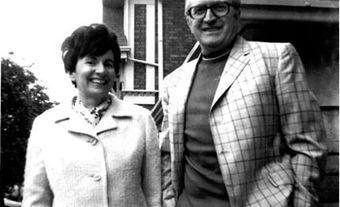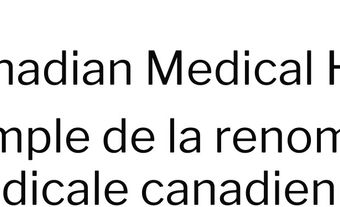James Edgar Till, OC, OOnt, FRS, FRSC, scientist, physicist, researcher, teacher (born 25 August 1931 in Lloydminster, SK). James Till and his colleague Ernest McCulloch conducted pioneering research into stem cells during the 1960s and 1970s (see Stem Cell Research). Their research inspired future developments in bone marrow transplants and other medical advances. (See also Medical Research.)

Early Life and Career
James Till was the son of a farmer who had migrated from England. He spent his childhood helping with the family farm, which he would continue to do during each fall harvest well into his scientific career. He studied at the University of Saskatchewan under Dr. Harold Elford Johns, a pioneer in the field of cobalt radiation treatment. Till went to Yale in 1954 on a fellowship provided by the National Cancer Institute of Canada. (See also Medical Research.) Though he was offered an assistant professorship there, Till decided to return to Canada in 1957, where he worked for Connaught Medical Research Laboratories at the University of Toronto.
In 1958, Till joined Harold Elford Johns at the Ontario Cancer Institute (OCI) after he turned down offers to work in biological and nuclear physics research. On why he chose to study cancer, he admitted in a 2012 interview with Maclean’s that it “sounded interesting” and “it wasn’t blowing anybody up.”
Stem Cell Research
James Till and Ernest McCulloch became acquainted at informal meetings held at the home of OCI biology division head Arthur Ham, who believed in encouraging cross-disciplinary work among the institute’s employees. McCulloch was interested in understanding the effects of radiation on mammalian cells and proposed studying mice who were subjected to lethal amounts of radiation. OCI physics division head Harold Elford Johns did not allow anyone to use on-site radiation machines without a physicist present. Till, who had reportedly enjoyed McCulloch’s presentations at Ham’s gatherings, volunteered to operate the machinery. Harold Elford Johns approved of their collaboration.
Part of the funding for Till and McCulloch’s research came from the Defence Research Board of Canada, which was interested in finding ways to treat radiation exposure in case a nuclear conflict broke out (see Defence Research). The experiments were conducted on seven groups of 25 mice aged 8–12 weeks. While studying the effects of radiation on bone marrow, they discovered that the injection of marrow cells into a host exposed to supralethal total body irradiation led to the formation of “colonies of proliferating cells” in their spleens. In 1960, McCulloch discovered lumps of cells on the spleens of the mice and that for roughly every 10,000 injected marrow cells, a nodule (or colony) was found on the spleen. The tests also showed that the longer the mice lived, the more the spleen cell colonies developed the basis of red blood cells, white blood cells and platelets. Subsequent testing showed that the treated cells would self-renew. They initially described the cells they discovered as “colony-forming units,” though the term “stem cell” had been first published by German scientist Ernst Haeckel in 1868. (See also Stem Cell Research.)
The results were submitted to the journal Radiation Research in July 1960 and published as “A Direct Measurement of the Radiation Sensitivity of Normal Mouse Bone Marrow Cells” in the February 1961 edition. “The paper represented an entirely new way of looking at how the body makes blood, not to mention presenting a raft of potential implications for other biological rethinks,” Joe Sornberger observed in his book, Dreams and Due Diligence (2011).
Further research led to two more journal articles published in 1963: “Cytological Demonstration of the Clonal Nature of Spleen Colonies Derived from Transplanted Mouse Marrow Cells” (Nature, 2 February 1963, in collaboration with research assistant Andrew Becker), and “The Distribution of Colony-forming Cells Among Spleen Colonies” (Journal of Cellular and Comparative Physiology, December 1963, co-credited with geneticist Louis Siminovitch). The findings stemming out of these studies showed that stem cells could help develop new bone marrow cells.
Till and McCulloch worked together for about two decades. Their research also led to the discovery that thymus and lymph node cells could be derived from the same clone as colony-forming cells in the hematopoietic system. Their work contributed to improvements in the treatment of anemia, leukemia and immunodeficient conditions (see Cancer; Disease).
Later Work
James Till headed the biological research division of OCI from 1969 to 1982. From the 1980s onwards, Till’s research interests covered various aspects of cancer care, including quality of life, research ethics, and the decision-making abilities of cancer patients. His main interest in the 21st century has been exploring the use of the Internet for advocacy, providing support and sourcing information. He is an advocate for open access to allow anyone to read research findings and papers.
In 1989, he was named chair of the Joint Task Force on the Future Needs for Biomedical Research in Canada. In 2001, he was appointed chair of the Knowledge Management Committee of the Stem Cell Network.
Legacy

Many observers compared the importance of James Till and Ernest McCulloch’s stem cell work to that of James Watson and Francis Crick into DNA during the early 1950s (see Genetics). Their works from the 1960s would be cited in thousands of future papers. When Till and McCulloch received the Albert Lasker Award for Basic Medical Research in 2005, Till summed up their achievements. “After 40 years, I think it means our work had stood the test of time reasonably well.”
Till speculated that the controversies surrounding stem cell research, ethics and politics delayed recognition of their work. However, neither Till nor McCulloch cared much about achieving fame for their work. “It’s very tough to produce creative work on schedule, and that’s what you have to do to maintain your celebrity status,” Till told the Toronto Star in 2005. “That kind of game is not for me. It never was.”
The legacy of their work was summarized by Evelyn Strauss of the Lasker Foundation in 2005. “They established the properties of stem cells, which still hold true today. Furthermore, they lay the foundation for the isolation of stem cells and for the detection of proteins that help these precursor cells develop and mature. Till and McCulloch’s discoveries explained the basis of bone marrow transplantation, which prolongs the lives of patients with leukemia and other cancers of the blood. Moreover, the team set a new standard of rigor for the field of hematology, transforming it from an observational science to a quantitative experimental discipline.”
In 2020, Canada Post honoured Till and McCulloch by issuing a stamp as part of a series depicting physicians and researchers.
Awards and Honours
- Fellow, Royal Society of Canada (1969)
- Canada Gairdner International Award, Gairdner Foundation (1969)
- Officer, Order of Canada (1994)
- Fellow, Royal Society of London (2000)
- Inductee, Canadian Medical Hall of Fame (2004)
- Albert Lasker Award for Basic Medical Research (2005)
- Member, Order of Ontario (2006)
- Inductee, Canadian Science and Engineering Hall of Fame (2010)
- Edogawa NICHE Prize, NCRM (2018)

 Share on Facebook
Share on Facebook Share on X
Share on X Share by Email
Share by Email Share on Google Classroom
Share on Google Classroom














